Strategies and Competitive Advantages of Samsung and Microsoft
VerifiedAdded on 2020/02/24
|9
|1413
|34
Report
AI Summary
This report provides a comparative analysis of the competitive advantages of Samsung and Microsoft. It explores the strategies employed by both companies, including Samsung's focus on innovation, product quality, and diverse distribution channels, as well as Microsoft's emphasis on productivity, cloud services, and strategic acquisitions. The report examines the business models of both companies, detailing Samsung's consumer electronics segments and Microsoft's developer community and software ecosystem. Furthermore, it applies the CAGE framework to assess the impact of cultural, administrative, geographic, and economic factors on each company's operations. The analysis highlights Samsung's adaptation to local markets and Microsoft's global presence. The report concludes with a discussion of the key factors that contribute to the competitive positioning of these two technology giants.
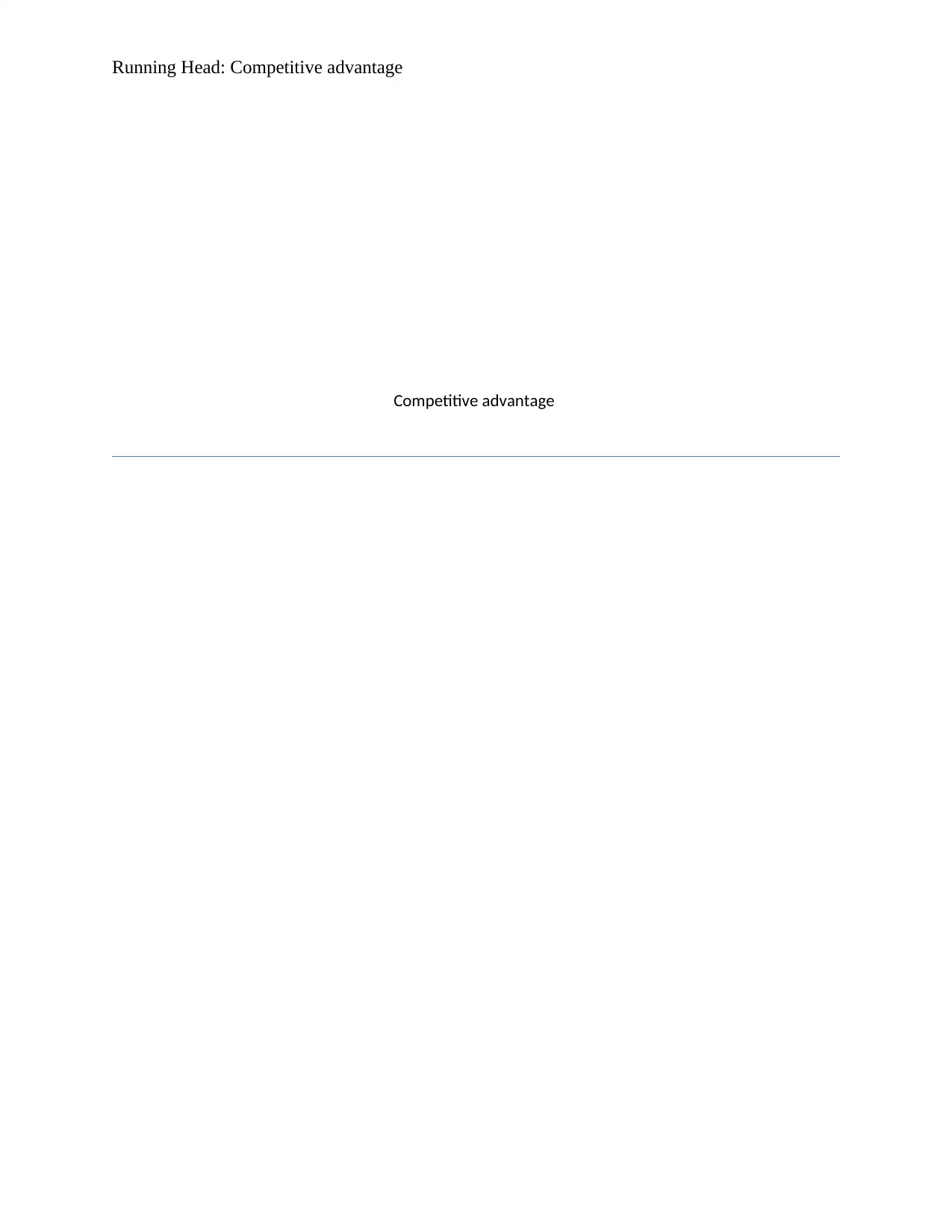
Running Head: Competitive advantage
Competitive advantage
Competitive advantage
Paraphrase This Document
Need a fresh take? Get an instant paraphrase of this document with our AI Paraphraser
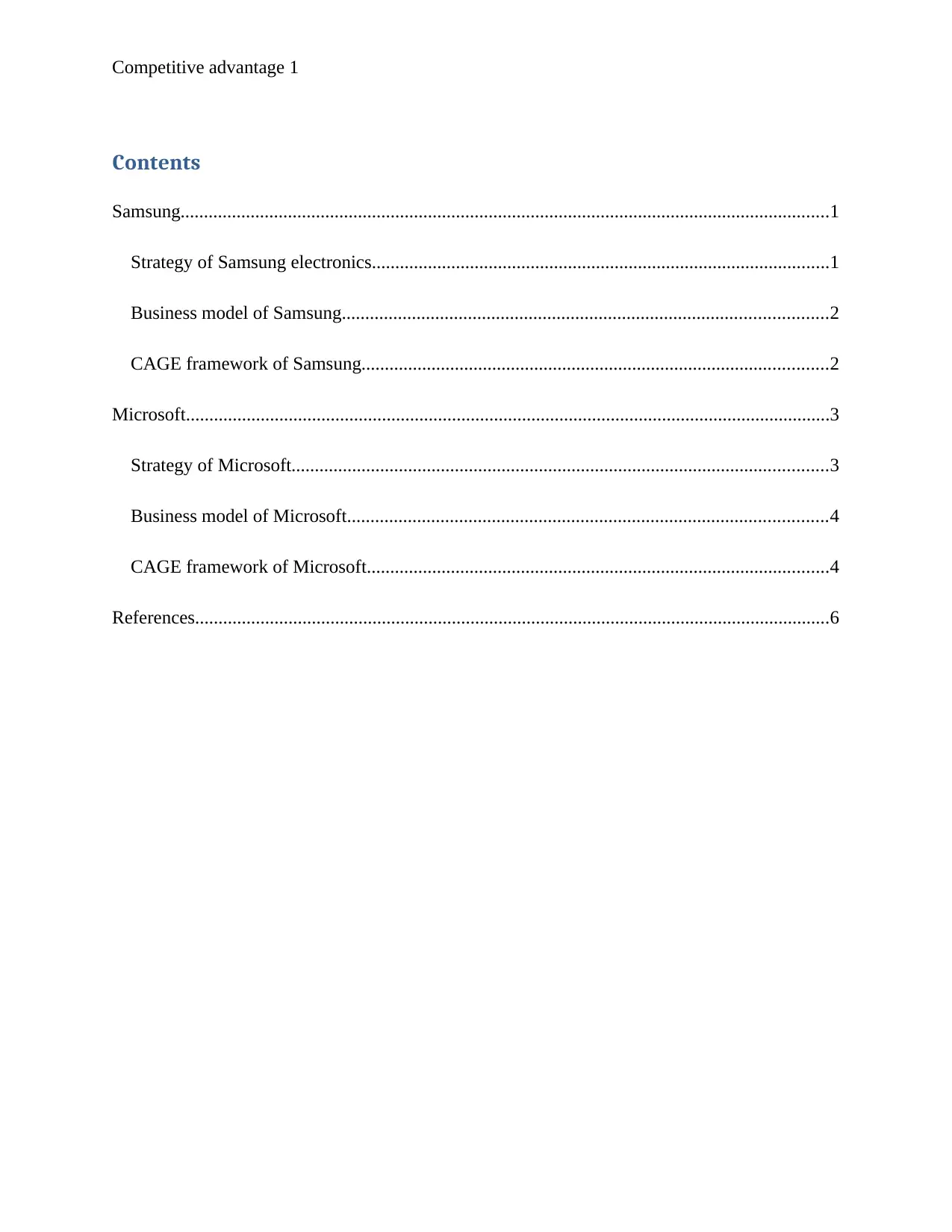
Competitive advantage 1
Contents
Samsung...........................................................................................................................................1
Strategy of Samsung electronics..................................................................................................1
Business model of Samsung........................................................................................................2
CAGE framework of Samsung....................................................................................................2
Microsoft..........................................................................................................................................3
Strategy of Microsoft...................................................................................................................3
Business model of Microsoft.......................................................................................................4
CAGE framework of Microsoft...................................................................................................4
References........................................................................................................................................6
Contents
Samsung...........................................................................................................................................1
Strategy of Samsung electronics..................................................................................................1
Business model of Samsung........................................................................................................2
CAGE framework of Samsung....................................................................................................2
Microsoft..........................................................................................................................................3
Strategy of Microsoft...................................................................................................................3
Business model of Microsoft.......................................................................................................4
CAGE framework of Microsoft...................................................................................................4
References........................................................................................................................................6
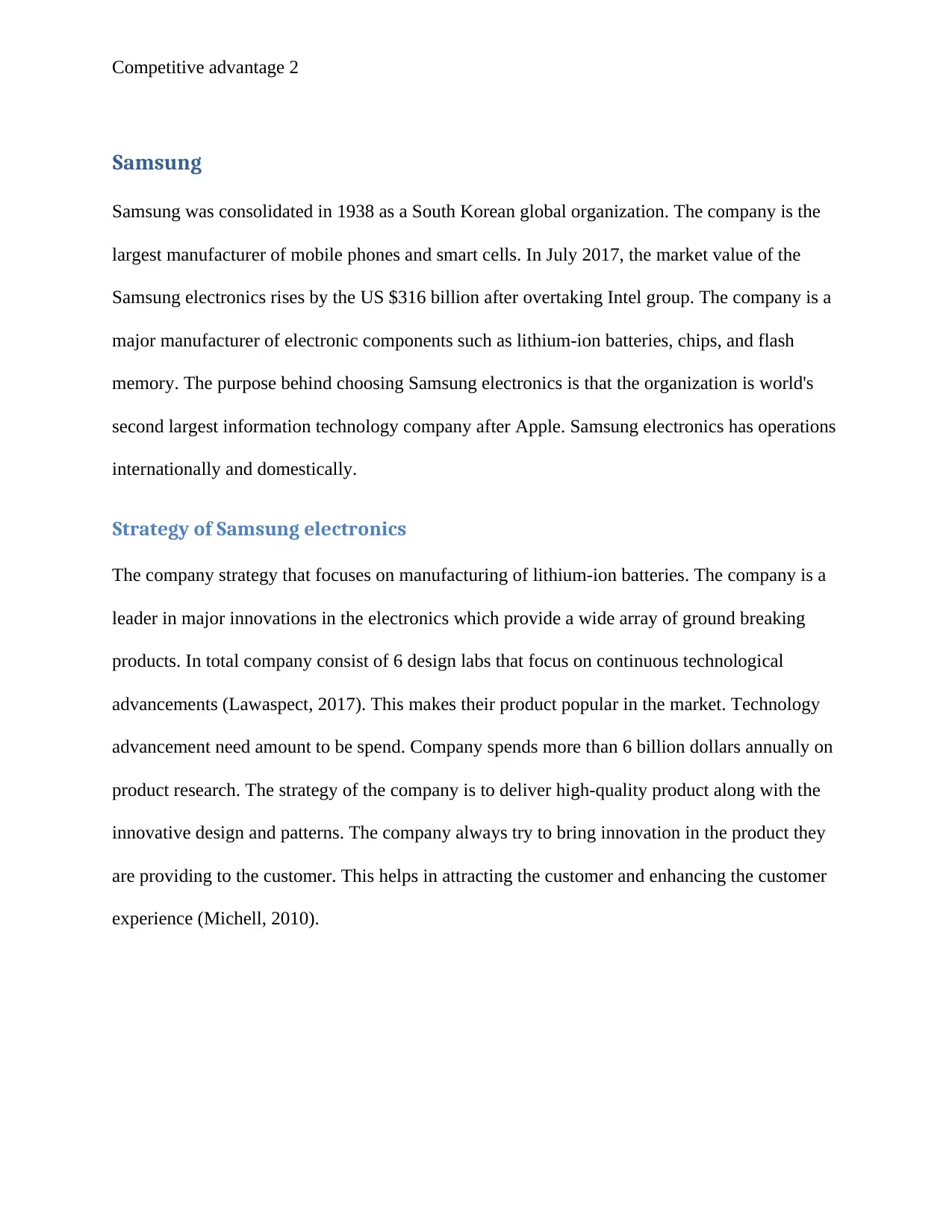
Competitive advantage 2
Samsung
Samsung was consolidated in 1938 as a South Korean global organization. The company is the
largest manufacturer of mobile phones and smart cells. In July 2017, the market value of the
Samsung electronics rises by the US $316 billion after overtaking Intel group. The company is a
major manufacturer of electronic components such as lithium-ion batteries, chips, and flash
memory. The purpose behind choosing Samsung electronics is that the organization is world's
second largest information technology company after Apple. Samsung electronics has operations
internationally and domestically.
Strategy of Samsung electronics
The company strategy that focuses on manufacturing of lithium-ion batteries. The company is a
leader in major innovations in the electronics which provide a wide array of ground breaking
products. In total company consist of 6 design labs that focus on continuous technological
advancements (Lawaspect, 2017). This makes their product popular in the market. Technology
advancement need amount to be spend. Company spends more than 6 billion dollars annually on
product research. The strategy of the company is to deliver high-quality product along with the
innovative design and patterns. The company always try to bring innovation in the product they
are providing to the customer. This helps in attracting the customer and enhancing the customer
experience (Michell, 2010).
Samsung
Samsung was consolidated in 1938 as a South Korean global organization. The company is the
largest manufacturer of mobile phones and smart cells. In July 2017, the market value of the
Samsung electronics rises by the US $316 billion after overtaking Intel group. The company is a
major manufacturer of electronic components such as lithium-ion batteries, chips, and flash
memory. The purpose behind choosing Samsung electronics is that the organization is world's
second largest information technology company after Apple. Samsung electronics has operations
internationally and domestically.
Strategy of Samsung electronics
The company strategy that focuses on manufacturing of lithium-ion batteries. The company is a
leader in major innovations in the electronics which provide a wide array of ground breaking
products. In total company consist of 6 design labs that focus on continuous technological
advancements (Lawaspect, 2017). This makes their product popular in the market. Technology
advancement need amount to be spend. Company spends more than 6 billion dollars annually on
product research. The strategy of the company is to deliver high-quality product along with the
innovative design and patterns. The company always try to bring innovation in the product they
are providing to the customer. This helps in attracting the customer and enhancing the customer
experience (Michell, 2010).
⊘ This is a preview!⊘
Do you want full access?
Subscribe today to unlock all pages.

Trusted by 1+ million students worldwide
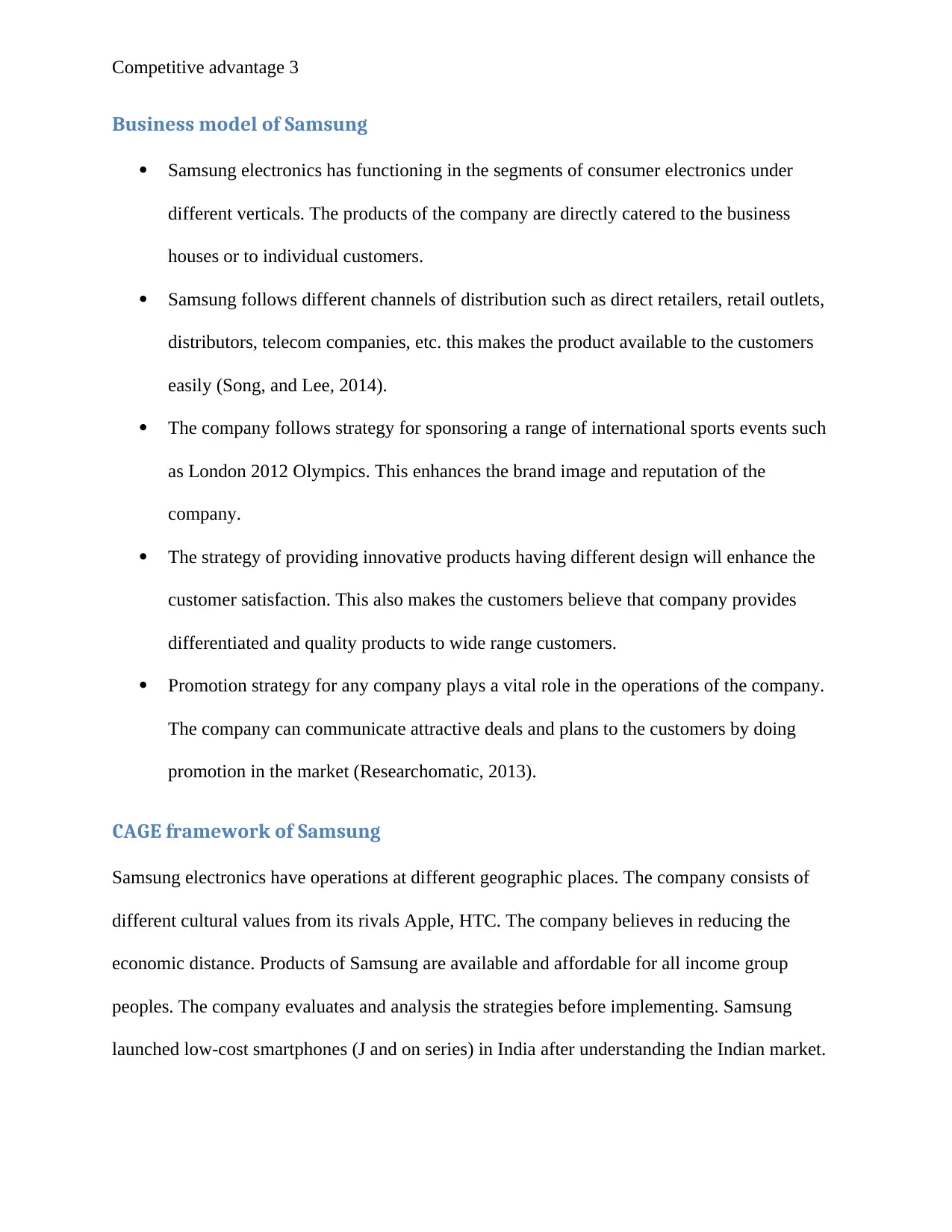
Competitive advantage 3
Business model of Samsung
Samsung electronics has functioning in the segments of consumer electronics under
different verticals. The products of the company are directly catered to the business
houses or to individual customers.
Samsung follows different channels of distribution such as direct retailers, retail outlets,
distributors, telecom companies, etc. this makes the product available to the customers
easily (Song, and Lee, 2014).
The company follows strategy for sponsoring a range of international sports events such
as London 2012 Olympics. This enhances the brand image and reputation of the
company.
The strategy of providing innovative products having different design will enhance the
customer satisfaction. This also makes the customers believe that company provides
differentiated and quality products to wide range customers.
Promotion strategy for any company plays a vital role in the operations of the company.
The company can communicate attractive deals and plans to the customers by doing
promotion in the market (Researchomatic, 2013).
CAGE framework of Samsung
Samsung electronics have operations at different geographic places. The company consists of
different cultural values from its rivals Apple, HTC. The company believes in reducing the
economic distance. Products of Samsung are available and affordable for all income group
peoples. The company evaluates and analysis the strategies before implementing. Samsung
launched low-cost smartphones (J and on series) in India after understanding the Indian market.
Business model of Samsung
Samsung electronics has functioning in the segments of consumer electronics under
different verticals. The products of the company are directly catered to the business
houses or to individual customers.
Samsung follows different channels of distribution such as direct retailers, retail outlets,
distributors, telecom companies, etc. this makes the product available to the customers
easily (Song, and Lee, 2014).
The company follows strategy for sponsoring a range of international sports events such
as London 2012 Olympics. This enhances the brand image and reputation of the
company.
The strategy of providing innovative products having different design will enhance the
customer satisfaction. This also makes the customers believe that company provides
differentiated and quality products to wide range customers.
Promotion strategy for any company plays a vital role in the operations of the company.
The company can communicate attractive deals and plans to the customers by doing
promotion in the market (Researchomatic, 2013).
CAGE framework of Samsung
Samsung electronics have operations at different geographic places. The company consists of
different cultural values from its rivals Apple, HTC. The company believes in reducing the
economic distance. Products of Samsung are available and affordable for all income group
peoples. The company evaluates and analysis the strategies before implementing. Samsung
launched low-cost smartphones (J and on series) in India after understanding the Indian market.
Paraphrase This Document
Need a fresh take? Get an instant paraphrase of this document with our AI Paraphraser
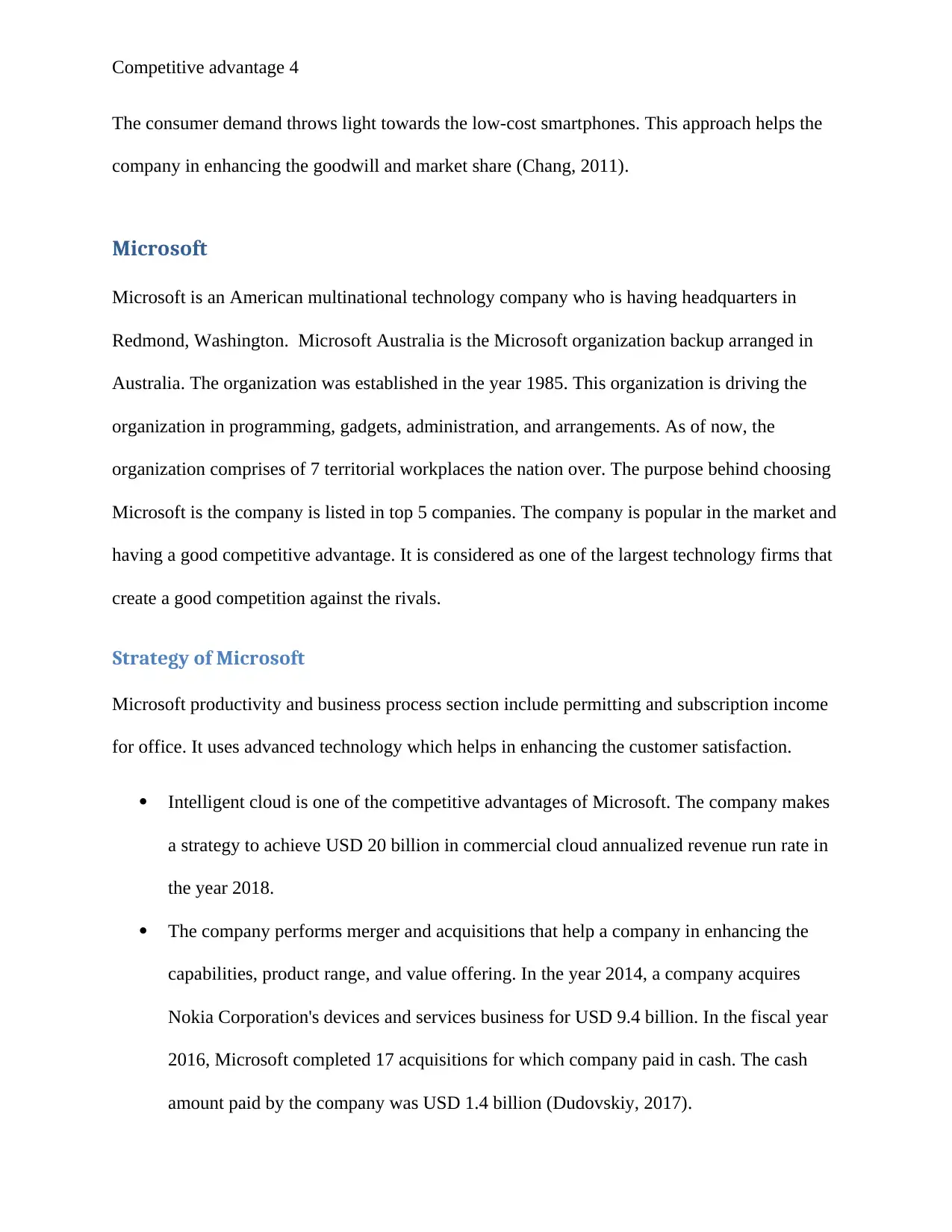
Competitive advantage 4
The consumer demand throws light towards the low-cost smartphones. This approach helps the
company in enhancing the goodwill and market share (Chang, 2011).
Microsoft
Microsoft is an American multinational technology company who is having headquarters in
Redmond, Washington. Microsoft Australia is the Microsoft organization backup arranged in
Australia. The organization was established in the year 1985. This organization is driving the
organization in programming, gadgets, administration, and arrangements. As of now, the
organization comprises of 7 territorial workplaces the nation over. The purpose behind choosing
Microsoft is the company is listed in top 5 companies. The company is popular in the market and
having a good competitive advantage. It is considered as one of the largest technology firms that
create a good competition against the rivals.
Strategy of Microsoft
Microsoft productivity and business process section include permitting and subscription income
for office. It uses advanced technology which helps in enhancing the customer satisfaction.
Intelligent cloud is one of the competitive advantages of Microsoft. The company makes
a strategy to achieve USD 20 billion in commercial cloud annualized revenue run rate in
the year 2018.
The company performs merger and acquisitions that help a company in enhancing the
capabilities, product range, and value offering. In the year 2014, a company acquires
Nokia Corporation's devices and services business for USD 9.4 billion. In the fiscal year
2016, Microsoft completed 17 acquisitions for which company paid in cash. The cash
amount paid by the company was USD 1.4 billion (Dudovskiy, 2017).
The consumer demand throws light towards the low-cost smartphones. This approach helps the
company in enhancing the goodwill and market share (Chang, 2011).
Microsoft
Microsoft is an American multinational technology company who is having headquarters in
Redmond, Washington. Microsoft Australia is the Microsoft organization backup arranged in
Australia. The organization was established in the year 1985. This organization is driving the
organization in programming, gadgets, administration, and arrangements. As of now, the
organization comprises of 7 territorial workplaces the nation over. The purpose behind choosing
Microsoft is the company is listed in top 5 companies. The company is popular in the market and
having a good competitive advantage. It is considered as one of the largest technology firms that
create a good competition against the rivals.
Strategy of Microsoft
Microsoft productivity and business process section include permitting and subscription income
for office. It uses advanced technology which helps in enhancing the customer satisfaction.
Intelligent cloud is one of the competitive advantages of Microsoft. The company makes
a strategy to achieve USD 20 billion in commercial cloud annualized revenue run rate in
the year 2018.
The company performs merger and acquisitions that help a company in enhancing the
capabilities, product range, and value offering. In the year 2014, a company acquires
Nokia Corporation's devices and services business for USD 9.4 billion. In the fiscal year
2016, Microsoft completed 17 acquisitions for which company paid in cash. The cash
amount paid by the company was USD 1.4 billion (Dudovskiy, 2017).
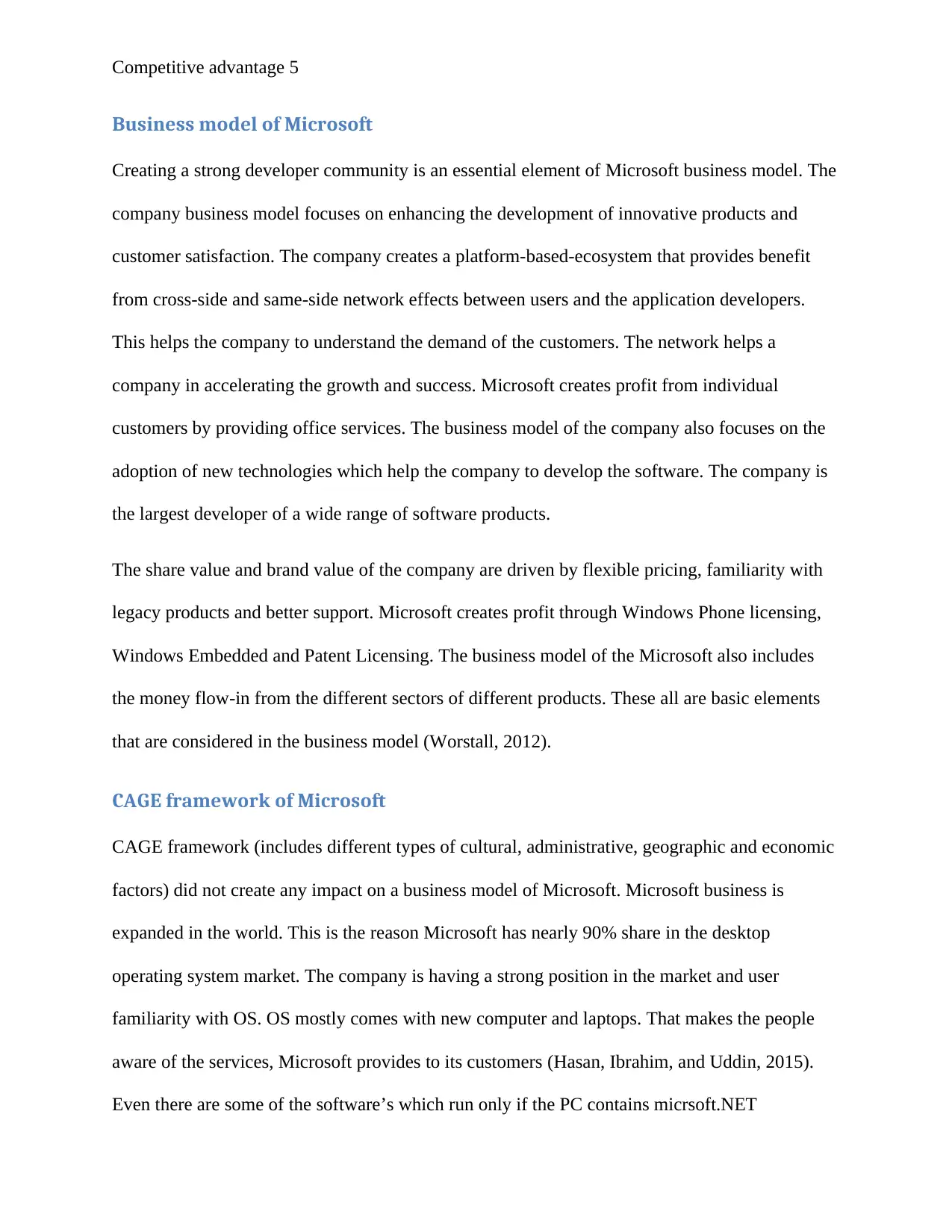
Competitive advantage 5
Business model of Microsoft
Creating a strong developer community is an essential element of Microsoft business model. The
company business model focuses on enhancing the development of innovative products and
customer satisfaction. The company creates a platform-based-ecosystem that provides benefit
from cross-side and same-side network effects between users and the application developers.
This helps the company to understand the demand of the customers. The network helps a
company in accelerating the growth and success. Microsoft creates profit from individual
customers by providing office services. The business model of the company also focuses on the
adoption of new technologies which help the company to develop the software. The company is
the largest developer of a wide range of software products.
The share value and brand value of the company are driven by flexible pricing, familiarity with
legacy products and better support. Microsoft creates profit through Windows Phone licensing,
Windows Embedded and Patent Licensing. The business model of the Microsoft also includes
the money flow-in from the different sectors of different products. These all are basic elements
that are considered in the business model (Worstall, 2012).
CAGE framework of Microsoft
CAGE framework (includes different types of cultural, administrative, geographic and economic
factors) did not create any impact on a business model of Microsoft. Microsoft business is
expanded in the world. This is the reason Microsoft has nearly 90% share in the desktop
operating system market. The company is having a strong position in the market and user
familiarity with OS. OS mostly comes with new computer and laptops. That makes the people
aware of the services, Microsoft provides to its customers (Hasan, Ibrahim, and Uddin, 2015).
Even there are some of the software’s which run only if the PC contains micrsoft.NET
Business model of Microsoft
Creating a strong developer community is an essential element of Microsoft business model. The
company business model focuses on enhancing the development of innovative products and
customer satisfaction. The company creates a platform-based-ecosystem that provides benefit
from cross-side and same-side network effects between users and the application developers.
This helps the company to understand the demand of the customers. The network helps a
company in accelerating the growth and success. Microsoft creates profit from individual
customers by providing office services. The business model of the company also focuses on the
adoption of new technologies which help the company to develop the software. The company is
the largest developer of a wide range of software products.
The share value and brand value of the company are driven by flexible pricing, familiarity with
legacy products and better support. Microsoft creates profit through Windows Phone licensing,
Windows Embedded and Patent Licensing. The business model of the Microsoft also includes
the money flow-in from the different sectors of different products. These all are basic elements
that are considered in the business model (Worstall, 2012).
CAGE framework of Microsoft
CAGE framework (includes different types of cultural, administrative, geographic and economic
factors) did not create any impact on a business model of Microsoft. Microsoft business is
expanded in the world. This is the reason Microsoft has nearly 90% share in the desktop
operating system market. The company is having a strong position in the market and user
familiarity with OS. OS mostly comes with new computer and laptops. That makes the people
aware of the services, Microsoft provides to its customers (Hasan, Ibrahim, and Uddin, 2015).
Even there are some of the software’s which run only if the PC contains micrsoft.NET
⊘ This is a preview!⊘
Do you want full access?
Subscribe today to unlock all pages.

Trusted by 1+ million students worldwide
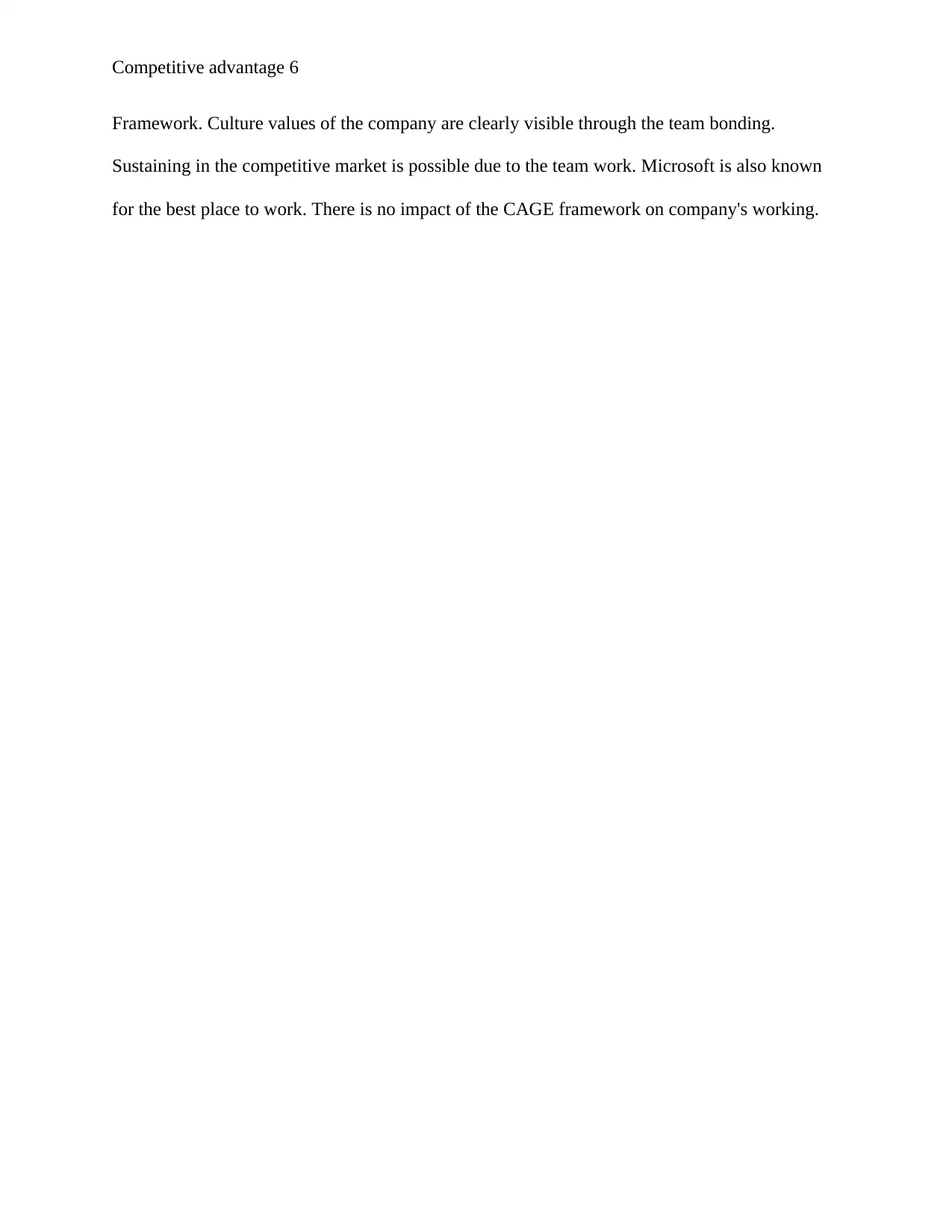
Competitive advantage 6
Framework. Culture values of the company are clearly visible through the team bonding.
Sustaining in the competitive market is possible due to the team work. Microsoft is also known
for the best place to work. There is no impact of the CAGE framework on company's working.
Framework. Culture values of the company are clearly visible through the team bonding.
Sustaining in the competitive market is possible due to the team work. Microsoft is also known
for the best place to work. There is no impact of the CAGE framework on company's working.
Paraphrase This Document
Need a fresh take? Get an instant paraphrase of this document with our AI Paraphraser
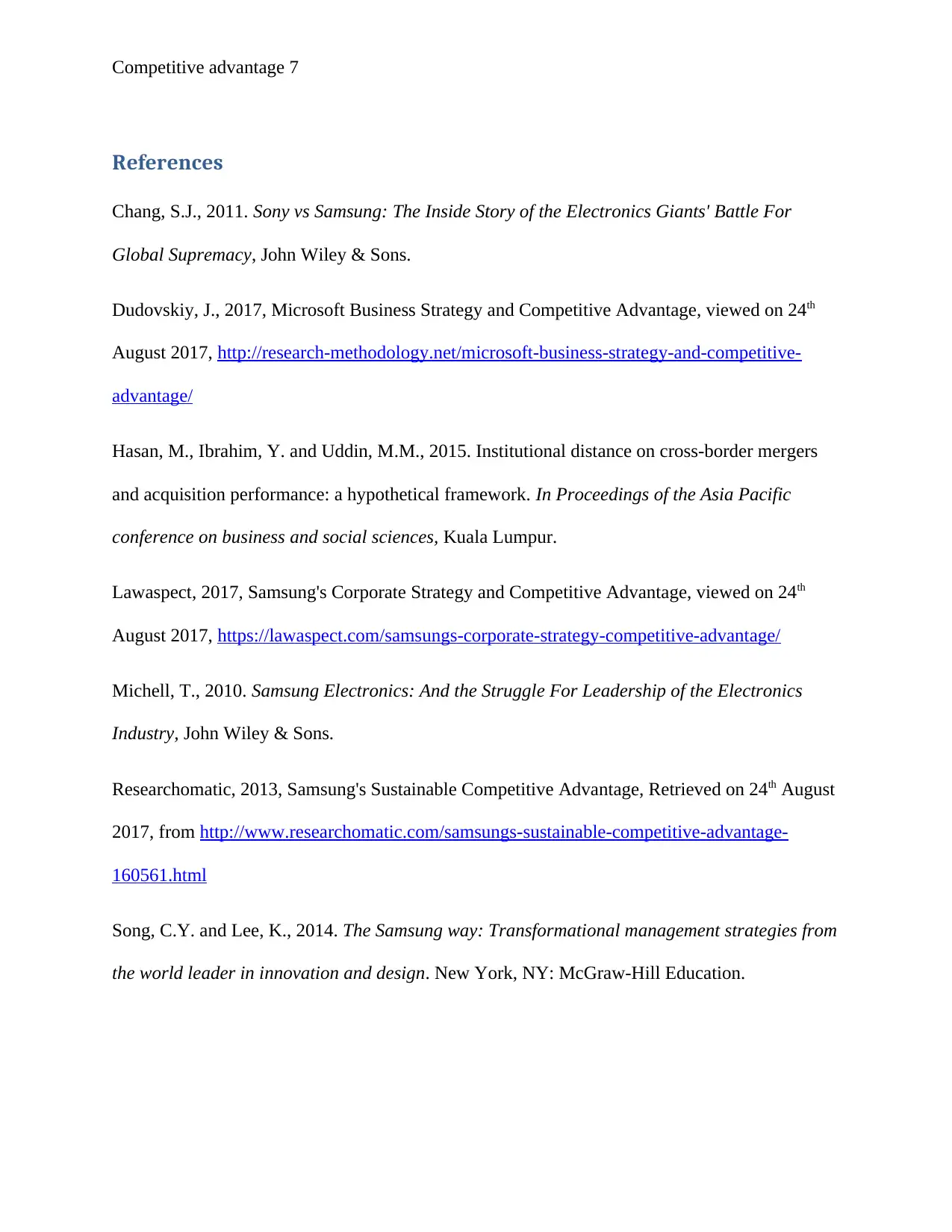
Competitive advantage 7
References
Chang, S.J., 2011. Sony vs Samsung: The Inside Story of the Electronics Giants' Battle For
Global Supremacy, John Wiley & Sons.
Dudovskiy, J., 2017, Microsoft Business Strategy and Competitive Advantage, viewed on 24th
August 2017, http://research-methodology.net/microsoft-business-strategy-and-competitive-
advantage/
Hasan, M., Ibrahim, Y. and Uddin, M.M., 2015. Institutional distance on cross-border mergers
and acquisition performance: a hypothetical framework. In Proceedings of the Asia Pacific
conference on business and social sciences, Kuala Lumpur.
Lawaspect, 2017, Samsung's Corporate Strategy and Competitive Advantage, viewed on 24th
August 2017, https://lawaspect.com/samsungs-corporate-strategy-competitive-advantage/
Michell, T., 2010. Samsung Electronics: And the Struggle For Leadership of the Electronics
Industry, John Wiley & Sons.
Researchomatic, 2013, Samsung's Sustainable Competitive Advantage, Retrieved on 24th August
2017, from http://www.researchomatic.com/samsungs-sustainable-competitive-advantage-
160561.html
Song, C.Y. and Lee, K., 2014. The Samsung way: Transformational management strategies from
the world leader in innovation and design. New York, NY: McGraw-Hill Education.
References
Chang, S.J., 2011. Sony vs Samsung: The Inside Story of the Electronics Giants' Battle For
Global Supremacy, John Wiley & Sons.
Dudovskiy, J., 2017, Microsoft Business Strategy and Competitive Advantage, viewed on 24th
August 2017, http://research-methodology.net/microsoft-business-strategy-and-competitive-
advantage/
Hasan, M., Ibrahim, Y. and Uddin, M.M., 2015. Institutional distance on cross-border mergers
and acquisition performance: a hypothetical framework. In Proceedings of the Asia Pacific
conference on business and social sciences, Kuala Lumpur.
Lawaspect, 2017, Samsung's Corporate Strategy and Competitive Advantage, viewed on 24th
August 2017, https://lawaspect.com/samsungs-corporate-strategy-competitive-advantage/
Michell, T., 2010. Samsung Electronics: And the Struggle For Leadership of the Electronics
Industry, John Wiley & Sons.
Researchomatic, 2013, Samsung's Sustainable Competitive Advantage, Retrieved on 24th August
2017, from http://www.researchomatic.com/samsungs-sustainable-competitive-advantage-
160561.html
Song, C.Y. and Lee, K., 2014. The Samsung way: Transformational management strategies from
the world leader in innovation and design. New York, NY: McGraw-Hill Education.
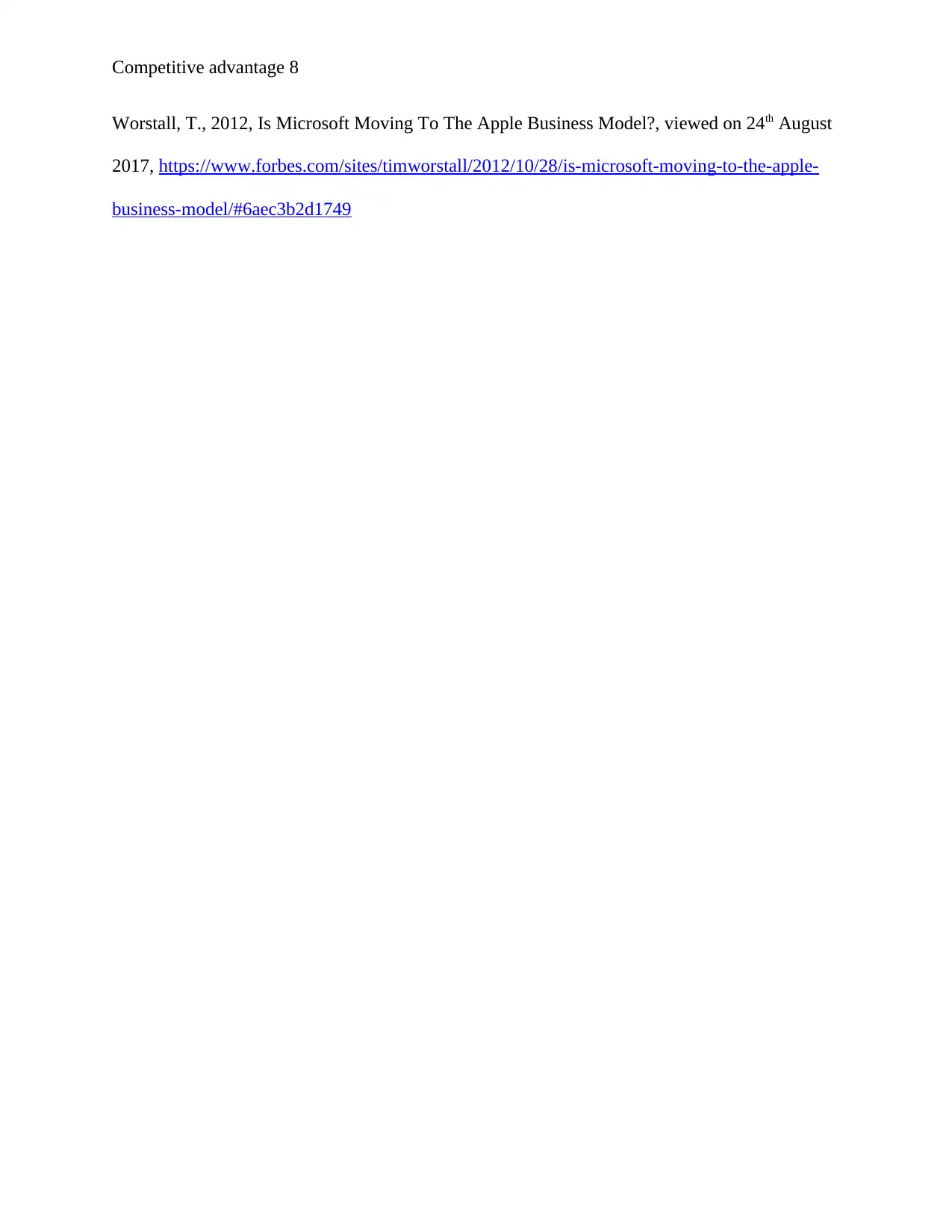
Competitive advantage 8
Worstall, T., 2012, Is Microsoft Moving To The Apple Business Model?, viewed on 24th August
2017, https://www.forbes.com/sites/timworstall/2012/10/28/is-microsoft-moving-to-the-apple-
business-model/#6aec3b2d1749
Worstall, T., 2012, Is Microsoft Moving To The Apple Business Model?, viewed on 24th August
2017, https://www.forbes.com/sites/timworstall/2012/10/28/is-microsoft-moving-to-the-apple-
business-model/#6aec3b2d1749
⊘ This is a preview!⊘
Do you want full access?
Subscribe today to unlock all pages.

Trusted by 1+ million students worldwide
1 out of 9
Related Documents
Your All-in-One AI-Powered Toolkit for Academic Success.
+13062052269
info@desklib.com
Available 24*7 on WhatsApp / Email
![[object Object]](/_next/static/media/star-bottom.7253800d.svg)
Unlock your academic potential
Copyright © 2020–2025 A2Z Services. All Rights Reserved. Developed and managed by ZUCOL.





